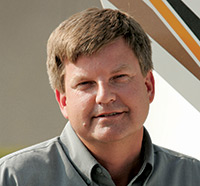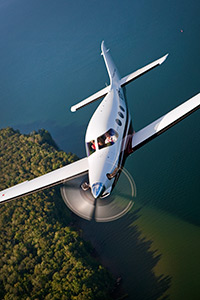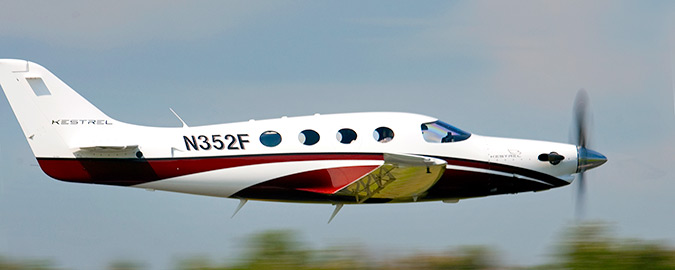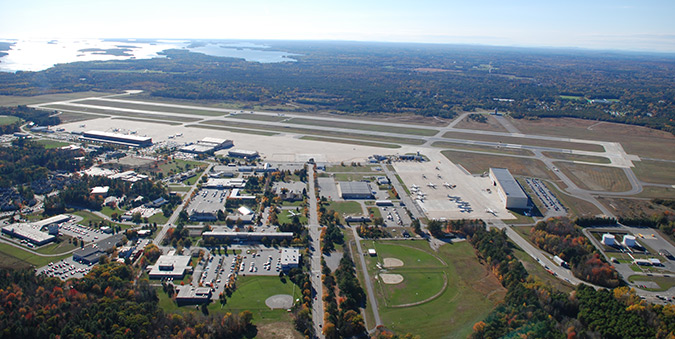Compelling Kestrel
Alan Klapmeier’s back with a new company—and a new airplane
The first time Farnborough Aircraft brought its Kestrel single-engine turboprop to then-Cirrus Aircraft CEO Alan Klapmeier, he was a no-show.
 “I don’t remember where I was that day, but it wasn’t at Cirrus headquarters [in Duluth, Minnesota] because I didn’t see the Kestrel at all,” he said. “Not that my being there would have changed anything because, at the time, I really wasn’t interested in a single-engine turboprop.”
“I don’t remember where I was that day, but it wasn’t at Cirrus headquarters [in Duluth, Minnesota] because I didn’t see the Kestrel at all,” he said. “Not that my being there would have changed anything because, at the time, I really wasn’t interested in a single-engine turboprop.”
Times and situations change, however, and when the Cirrus board unceremoniously booted Klapmeier in early 2009 from the start-up he had helped build into an industry leader, Klapmeier began searching for his next act. First, he moved to purchase the unfinished Vision single-engine jet that he had helped launch at Cirrus, but the two sides were unable to come to terms.
Then Klapmeier began a new search—not for a single aircraft design, but the engineering, financial, and marketing combination that could make a whole family of new aircraft. After five months evaluating different products, teams, and strategies, Klapmeier came back to the British firm that designed the one-off Kestrel prototype. This time, he was convinced that the sleek, six-seat, 340-knot composite aircraft that he had missed on the day that it came to him was the right launching pad for his return to general aviation manufacturing.
 “This is a composite airplane used for personal transportation, and that’s an area I’m very familiar with,” said Klapmeier, now CEO of the renamed Kestrel Aircraft Company. “I know the certification and production issues, and I know the market. This is the right start. They really do build a better mousetrap.”
“This is a composite airplane used for personal transportation, and that’s an area I’m very familiar with,” said Klapmeier, now CEO of the renamed Kestrel Aircraft Company. “I know the certification and production issues, and I know the market. This is the right start. They really do build a better mousetrap.”
That’s not to say that Klapmeier, designer of a handful of Experimental-category aircraft (including a single-engine, composite turboprop before starting the FAA-certified Cirrus line, doesn’t see room for improvement in the Kestrel. Klapmeier and his new team expect to make many alterations: The wing is likely to grow in area, the cabin will expand for greater roominess, the cockpit will become easier to climb in and out of, and control surfaces will get bigger to improve low-speed handling. As a result, the Kestrel’s top speed and stall speed are sure to be reduced.
“We’re still evaluating the cost and performance tradeoffs,” Klapmeier said. “I’d rather have a five-knot-slower stall speed than an additional 20 knots in cruise—as long as the cruise speed stays over 300. Even with the changes we’re talking about, I think our cruise speed is going to be very respectable, likely around 325 knots.”
Klapmeier said the Kestrel’s target price is between $2.5 million and $3 million, and that its physical dimensions will be larger than those of a TBM 850 and smaller than those of a Pilatus PC–12. An airframe parachute, which Klapmeier had insisted that all Cirrus aircraft include as standard equipment, will be an option in the Kestrel.
“Our job isn’t to give the customer what he wants. It’s to give the customer what he’s going to want in the future—and that’s not necessarily the same thing,” he said.
Klapmeier has already reconstituted some of the original Cirrus design team to lead a Kestrel makeover and expand the product line. He also remains convinced that a single-engine jet can be a bigger seller than any turboprop.
“Turboprops weigh more and cost more,” Klapmeier said. “There’s a market for them among people who need to lift more weight or take off and land at shorter runways. But a single-engine jet still wins in most scenarios, and I still think the single-engine jet has the larger market.”
If that sounds like Klapmeier’s heart isn’t really in the Kestrel project and he’s already looking ahead to other programs, he insists that perception is wrong. “My heart isn’t in a single-engine jet,” he said. “It’s in a whole line of products.”

We’re going to argue
Klapmeier expects the new firm to manufacture and sell up to 75 turboprops a year at its facility in Brunswick, Maine, a sprawling former U.S. naval air station that has been used for decades to operate, house, and maintain a fleet of antisubmarine aircraft that patrol the Atlantic.
The process of converting a hangar building built in 2005 to hold a half-dozen P–3 Orion submarine hunters into an aircraft production factory “isn’t as complicated as you might think,” Klapmeier said. There’s plenty of vacant space, power, and runway access. And the industrial ovens and specialized equipment for making composite aircraft components can be brought in and out relatively easily.
There’s no history of aircraft production in coastal Maine, but Klapmeier said the absence of aerospace manufacturing experience doesn’t bother him.
“Maine isn’t top of mind when it comes to aerospace manufacturing, but neither was Duluth when Cirrus came to Minnesota,” he said. “The important thing is that people in Maine know how to build things that look good and work well, and you can see that in the marine industry there. We’ll be able to apply those same kinds of skills and craftsmanship to aircraft production.”
All the major Kestrel subassemblies will be built in Brunswick, and final assembly will take place there as well. The company recently began advertising to attract its first new hires to the area. Klapmeier expects Kestrel to employ about 300 workers in Maine when production is in full swing. The company planned to begin occupying the former P–3 maintenance hangar in December.
By that time, the core team of designers and planners had been in place for several months. Steve Serfling and Mike Van Staggen, both Cirrus veterans, will play central roles in Kestrel design, certification, and production. Klapmeier has long eschewed formal titles and says the critical measure is how top executives perform as a team. He jokingly refers to Serfling and Van Staggen as “Thing One and Thing Two,” a nod to Dr. Seuss, and says Van Staggen will be responsible for defining exactly what the Kestrel is, while Serfling will decide how it gets done.
Klapmeier plans to divide his time between his family’s home in Minnesota and the company’s production facility in Maine. He estimates it will take up to $120 million to finish the design and certification work for the new aircraft and start production. The company has raised about half that amount already, largely through state and federal grants tied to the closure and reuse of the naval air station.
Attracting funding for the project has been especially difficult in the current economic environment where banks are reluctant to lend, venture capital is scarce, and investors insist on absolute control.
Klapmeier, still smarting from being pushed out by Cirrus majority owner Arcapita, has insisted from the outset that no one will control more than 50 percent of the new company. “We’re going to have a real board of directors,” he said, “and we’re going to argue about things. I don’t mind doing things someone else’s way. But they’ve got to at least listen to my point of view. I’ve already offended some potential investors by telling them that they’re not going to have total control. No one will.”
Klapmeier said Kestrel intends to raise the necessary capital through economic development grants, and angel and institutional investors. The company is not seeking public ownership through an initial public stock offering (IPO).
“Kestrel isn’t looking at an IPO for two reasons,” he said. “First, it’s the wrong ownership model. And second, it’s impossible in this economic environment. That’s why leveraging the economic development money this project has attracted is so critical.”

Lots of attention
Ever since Klapmeier announced that he was forming the Kestrel Aircraft Company to produce airplanes in Maine—just before EAA AirVenture 2010 in Oshkosh—the news has brought renewed interest to the airplane, and lots of attention to the newly formed company.
Since then, he’s flown the Kestrel extensively and displayed it at the National Air Races in Reno, Nevada, and elsewhere. The prototype is based near Duluth and was scheduled to move to Maine in early 2011. It’s far different than the first turboprop he and brother Dale Klapmeier designed and built. The ST50 was a five-seat pusher design that bore a strong resemblance to the VK30 kits the two used to offer homebuilders.
But Klapmeier said the more he’s flown the Kestrel prototype, the more convinced he is that it can succeed in the marketplace, and that the marketplace for owner-flown turboprops is likely to expand in the United States and overseas.
“The Kestrel is not going to be as fast as a jet, but it will get in and out of runways that jets can’t, and it will have great handling qualities and docile stall characteristics,” he said. “It’s going to be a very compelling airplane.”
E-mail the author at [email protected].
The Klapmeier mold
Alan Klapmeier is starting the Kestrel program with a flying prototype, unlike previous airplanes that he and associates have designed and built from scratch—a move Klapmeier said will save years and tens of millions of dollars in development and certification costs. Klapmeier began designing and building airplanes while he was a physics and economics student at Ripon College in Wisconsin and founded Cirrus Design there in 1984. Although the aircraft he has designed have included Experimental-category kits and Standard-category models, all have been made from sleek composite materials—and the Kestrel fits that mold as well.

VK30
Designed in the early 1980s, the VK30 first flew in 1988. A 300-horsepower Continental IO-550 powered the four-seat airplane. The VK30 was large and extremely complex by kit standards, however, and relatively few were finished and flown.
ST50
Built under a license to an Israeli aviation firm, the five-seat pusher turboprop first flew in 1994. The aircraft was reputed to have excellent handling qualities but the design never went into production.
SR20
The first FAA-certified aircraft that Cirrus produced included new safety features such as an airframe parachute. A 200-horsepower Continental IO-360 powers the four-seat, fixed gear airplane that became extremely popular with individual owners and flight schools alike.
SR22
A more powerful, higher-flying Cirrus became a market leader in the 2000s with both normally aspirated and turbocharged models.
It also brought glass-panel avionics to the single-engine general aviation market and remains popular among individual, corporate, and fractional owners.
SF50
The single-engine Vision Jet was designed to be the “slowest, lowest, and cheapest” FAA-certified jet available to private owners and pilots, Klapmeier said. Flight characteristics and avionics on the 300-knot Vision are meant to be as similar as possible to the SR22, and many Vision buyers are expected to make the jump from flying single-engine piston aircraft to the single-engine jet.


